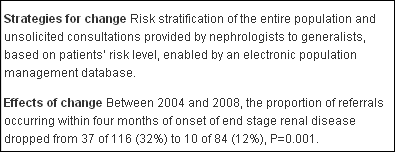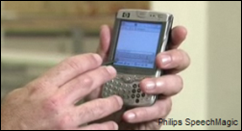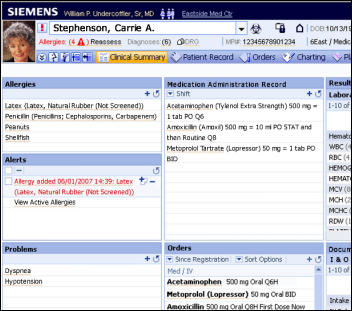I dont think anything will change until Dr Jayne and others take my approach of naming names, including how much…
Monday Morning Update 7/13/09
From afh15: “Re: EHR data. I’d love to read your thoughts on this study and the long-term uses of EHR data in preventive care.” I don’t have access to the full text of the article, but I truly believe that once the pain of getting EMRs running as data collection appliances is over (meaning we’ve got data collection clerks known as doctors and nurses in place, which is the “pain” part), the benefit will be incredible. This article apparently deals with having nephrologists automatically consulted when the EHR finds problems. There are other benefits. You could do society-improving medical research by just slicing and dicing data from millions of patients, at least the parts of it that aren’t just clinical-sounding billing events that are useless or even misleading. You could find candidates for research trials. Patients could be followed over many years, even as they move around and use the services of a variety of providers. And for individual patients, there could be great value in putting research findings into the hands of front line doctors. Not to mention giving patients a platform whereby they can participate in their own care and add non-episodic information related to lifestyle, personal health assessment, etc. Clinical systems will not save time, as clinicians know – they exist to create data whose value mostly accrues to someone else. My advice to providers: much of your future income may be based on the data you create and the ownership in it you retain. Don’t be like the Native Americans and let greedy outsiders buy your land for trinkets.
From Anonymous: “Re: Craneware. Interesting question to ponder: How did two young Scot lads, with no US healthcare knowledge, manage to visualize and create Craneware, the country’s first automated CDM software based on complex Medicare regulations? The designer of Craneware’s core CDM products is a US healthcare consultant and not a Scot. Nora McNeil (NJ) is Keith Neilson’s American mother-in-law. She co-founded Craneware with KN and his partner Gordon Craig and taught the Scots everything they needed to know about US healthcare policy and regulations. She was also the sole marketing and salesperson of Craneware’s CDM products for the first two years of the company’s existence. So why have the duo not publicly acknowledged Nora’s existence as a founding partner and her primary role in creating a successful company?” The company’s documents say it was founded by Keith Neilson and Gordon Craig “following on from discussions with Nora McNeil.” I would guess there’s a family squabble somewhere in the mix. And when that happens, the lawyers are usually not far behind. I don’t have a horse in the race, so I’m neutral.
From Cracker: “Re: Nuance. Nuance’s domination of health care speech recognition gets more scary when you also consider the current M*Modal customers taking a serious look at Nuance. I know second hand of two current M*Modal customers looking at Nuance and will do some research to find some more.” Cracker references a news piece describing an anti-trust investigation of Nuance’s $96 million acquisition last year of Philips Speech Recognition systems (the old SpeechMagic). My assumption, reading between the lines, is that a competitor complained and the investigation is just making sure Nuance isn’t raising prices after knocking off Philips (not likely since Philips had minimal US presence). I don’t know much about M*Modal so I don’t know how they stack up to Nuance, but they and a few other vendors are facing a large, highly successful, and aggressive competitor whose name is nearly synonymous with speech recognition.
From Captain Hook: “Re: Valco rumor. We are a current client and since the announcement have spoken with a couple of our prior contacts at Valco (and they appear to still be working for the company). It is clear that some of them have been let go. Spoke to AJ Hyland as well. No indication that Valco technology will be sunsetted, at this point but it would make sense to do so. It is clear that Hyland bought the client base and entree into Meditech clients.” Valco sold portals, electronic forms, scanning solutions, and other healthcare tools.
From Commander Cody: “Re: Medical Center Odessa. They paid $6.2 million for CPOE, but their regional neighbor Midland Memorial paid only $7 million for their entire clinical transformation project. After five years, Odessa is just now doing McKesson CPOE, two years after Midland has fully implemented OpenVista hospital-wide. Taxpayers paying for high-priced proprietary EMR systems is a bad idea.”
Should CPOE be a requirement for demonstrating meaningful use of hospital-based EMRs? Yes, according to 69% of those who answered my poll. New poll to your right, inspired by the comment above: should hospital CIOs consider open source clinical systems?
McGill University Health Centre is working with Medical.MD to develop its MedforYou PHR.
The local paper covers EMR implementations in two Arizona hospitals. Banner Health, the story says, will spend $30 million (hardware, software, and training) each at two of its hospitals: 430-bed Banner Boswell and 272-bed Del E. Webb. They’re Cerner, I believe. I hope that dollar figure is a misprint, but then again, Banner paid its CEO $2.7 million, the CFO $1.7 million, and its CIO $600K in 2007, so maybe big numbers don’t bother them. Its 2007 profits … sorry, “surplus” …, was over $300 million. Since they’re not paying taxes, I guess the money has to go somewhere.

Say hello to TELUS Health Solutions, supporting HIStalk as a Platinum sponsor. The company, which took a big jump up the HCI Top 100 this year from #33 to #20, offers a wide range of healthcare solutions (claims management, the new TELUS Health Space personal health platform, pharmacy management systems, telehealth, patient and resource scheduling, and the renowned Oacis Unified Patient Record). The open architecture Oacis, in fact, has been supercharged into an integration platform that offers an integration gateway, EMPI, CPOE, ED tracking, clinical documentation, Web-based Enterprise EMR, and data warehouse/BI portal, making it suitable for healthcare organizations and entire regions. I remember from talking to the folks there awhile back that Oacis has two big strengths: it can handle the interoperability requirements of regional deployments and for hospitals, it can be implemented without ripping and replacing (it also excels at being customizable, as I recall). OK, I’m prattling on because I was pretty charged up with Oacis when people started telling me about it years ago, but for now, let’s leave it at this: thanks to TELUS Health Solutions for supporting HIStalk.
Cerner moves up to the Nasdaq-100 Index, replacing the Oracle-acquired Sun Microsystems.
HIMSS is thinking more and more like a vendor. How do they improve (“reposition”) the perception of its CPHIMS certification credential? Hire a marketing company to develop a “correlating creative platform and 12-month integrated communications plan.” Because of the tsunami of federal HIT dollars, “the CPHIMS new brand positioning will be more essential than ever,” at least in the eyes of the marketing people (a knowing wink to fellow grammar zealots: “more essential” makes no more sense than “more pregnant”).
The California Nurses Association union files a complaint with the state’s Department of Public Health, alleging that UC Irvine Medical Center has overdosed at least five patients with narcotics by using malfunctioning Curlin infusion pumps that let patients control the flow of pain med IVs. The hospital disagrees, saying keystroke logs indicate that in at least three of the cases, nurses entered the wrong dosage. Meanwhile, an enterprising group of ambulance-chasing lawyers has bought Google search ads trolling for victims who have “sustained damage” after a Curlin pump recall, helpfully noting that companies have to pay out even if they weren’t negligent under current strict product liability laws. Maybe the lawyer proceeds of healthcare-related lawsuits should be taxed at some reasonable rate (90%?) to help fund healthcare reform since the former lawyers in Congress keep avoiding tort reform.
Industry long-timer Bob Fetters died Tuesday at 70 in Kennett Square, PA. He worked for over 20 years at SMS and had already RSVP’ed for Vince Ciotti’s November reunion. The memorial service was Saturday morning, but messages for the family can be left here. Condolences.
I like this fresh thinking: if we’re already paying double what most countries pay for healthcare, why should healthcare reform cost anything? I also like this answer: “We owe the insurance companies, pharma, etc. a severance package, payable into the future for some undisclosed period of time. Like the Hotel California, their lobbyists are making sure we can check out anytime we like, but in fact, we can never leave.”
Former Cernerite Anne Jamieson is named CEO of Portsmouth Regional Hospital (NH).
A hospital in Canada whose computer network was infected with the CoreFlood trojan horse sends warning letters to 11,500 patients, warning that the trojan was designed to capture information and send it to hackers and therefore may have done so. The virus was not detected by the hospital’s unnamed antivirus software (considering that Symantec has been protecting against it since 2002, maybe it’s time to check the updates, change vendors, or fire employees who disabled it on their PCs). CoreFlood was written by hackers in southern Russia to capture secure information such as passwords, e-mail contents, and bank records. It’s doing its job, collecting 500G of personal financial information in just six months, including details on thousands of banking and credit card accounts.
Siemens will provide Soarian to 37 hospitals and 300 clinics in South Africa as a subcontractor. That’s a huge and much-needed deal for Soarian, which was always loaded with unrealized promise.
The VA gets $3.3 billion to spend on IT in 2010, up 30% from 2009.
West Jefferson Medical Center (LA) gets a mention from the local TV station for its implementation of GetWellNetwork, explaining that it’s not for just patient entertainment, but also patient education. The article says patients can also find a hotel, check their bill, and send an instant message to hospital departments.
I like this opinion piece on Taj Mahospitals: “If your competitors have serious woodwork, you can’t get by with woodgrain Formica. If they have armies of PR people on staff, you need them, too. If they have billboards touting the No. 1 rating conferred on their pediatric nephrology team by a local magazine, you too need billboards. If they offer their patients such amenities as wireless Internet, on-demand video, room service-style dining and concierge service, you’d better follow suit. In fact, a recent study published by the National Bureau of Economic Research found that such amenities are three times as effective in increasing demand for a hospital’s services as improved clinical results are. (What? We don’t care if we get better as long as we can have YouTube and American Idol on tap?) The irony is that it’s all necessary, even though it’s a total waste in the sense that none of it improves anybody’s health one iota.”
Scary stats out of California, not like to improve now that the state is nearly bankrupt: the state’s nursing board takes an average of three years to investigate and discipline problematic nurses, gives probation to offenders but doesn’t crack down when they mess up repeatedly, and doesn’t have records to keep fired and disciplined nurses from moving on to the next hospital. One nurse kept his license for five years after hospital complaints that he had stolen and used drugs and fell asleep while performing CPR; he admits he was high at work.
Cleveland Clinic launches its health and wellness portal.
Dossia announces an API for its PHR platform, allowing programmers of new personal health tools to exchange information with it. Documentation for it is here.
Insurance company UnitedHealth Group announces that it will spend tens of millions of dollars to build a national telehealth network based on Cisco’s Telepresence technology. It has hired former MinuteClinic CMO Jim Woodburn to run the program. More details will be announced on July 15.








“Taj Mahospitals”
There is much meaning in that phrase and could be the manta of an entire movement to change healthcare in America.
Can’t afford healthcare coverage for everyone: Taj Mahospitals
Healthcare insurance rates are going through the roof: Taj Mahospitals
Medicare reimbursement rates are too low: Taj Mahospitals
Nurse productivity and staffing levels: Taj Mahospitals
…..
The public should ask how important is this CPHIMS certification credential, considering that the entire HIMSS C-suite does NOT have this certification, nor do most of its staff, http://www.himss.org/content/files/CPHIMS_Certificants_by_State.pdf. In fact, several HIMSS B.O.D. have allowed their CPHIMS certification to lapse in favor of the FHIMSS designation. If the HIMSS B.O.D sees no value in renewing its CPHIMS certification, then here is NO marketing campaign that can change the fact that HIMSS appears not to value its own CPHIMS certification credential. This is the same HIMSS B.O.D. that has allowed Mark Leavitt, CCHIT Chair, to receive a full compensation package for the past four years, even though he was no longer an employee of HIMSS since 2005.
The CPHIMS credential requires the passing of an examination, and the CPHIMS credential renewal requires documentation of approved continuing professional education activities every three years or through retaking and passing the CPHIMS examination. Advancement to Fellow status of HIMSS requires acceptance of an application demonstrating service to the organization. There are no FHIMSS renewal requirements.
Ms. Kohn, the HIMSS B.O.D. does not require FHIMSS applicants (including themselves) to have the CPHIMS credential. And you are correct, there are no requirements for FHIMSS renewal requirements, only CPHIMS. That does not explain why some of the B.O.D. have allowed their CPHIMS certifications to lapse, why most HIMSS staff do not have the credential, and why there is not a strong renewal rate for maintaining the CPHIMS certification credential. The CPHIMS credential would carry more weight if the HIMSS B.O.D., C-Suite, and managerial staff were required to take and pass the CPHIMS exam to add credibility for this credential, instead of hiring a marketing company to tweak their “brand” so that HIMSS can have access to the “tsunami of federal HIT dollars”. It appears everything HIMSS does is motivated by money. HIMSS likes to dictate policy across the HIT community, including with CCHIT, but they do not follow the letter and spirit of the law when it comes to ethical, moral and professional standards, especially with the IRS.
Why are you HIMSS guys not certified with your own credential? HUMM, lets see… you all ready have the answers to the questions. OOPS that would be cheating! So lets preserve the illusion of fairness and just go after the tax payers wallet with the humm drum beat of marketing CPHIMS to the membership strategy.
A little diversion and some distraction ( throw in some salt and pepper, maybe lots of salt) , nobody will realize its just hot air and the credential is basically an all day pass to the fat lady show at the circus. Oh boy, lots of fun!
Your reference to the AZ newspaper article on Del Webb and Boswell is interesting. Prior to their acquisition by Banner Health, both hospitals had been QuadraMed Affinity customers since the mid 90’s. Since Banner uses Cerner, does Affinity not count for EMR or was that just “practice”, waiting for the real one to be installed by the acquiring Hospital?
I just read the press release for CPHIMS certification: “The creative direction of the new CPHIMS brand position uses a distinctive testimonial approach to deliver a message of credibility from CIOs and VP-level executives. A new logo with the tagline, ‘The Mark of a Proven Leader’ accompanies the campaign.”
The new marketing tagline should read “Mark of the Beast.”
Where is H. Stephen Lieber in all recent articles and press releases? Has he stepped down from his dual roles as HIMSS CEO and CCHIT Trustee Chair?
This is NO “Ivy League” credential. This isn’t even rag weed league.
Commander Cody seems unfamiliar with the concept of value. Lauding McAllen’s Vista decision vis-à-vis Odessa’s based on cost and implementation time is ludicrous. Doubtless healthcare in McAllen is the best and most affordable care anywhere? Not really; read this article (http://www.newyorker.com/reporting/2009/06/01/090601fa_fact_gawande?currentPage=all) for an excellent discussion of the critically ill state of McAllen’s healthcare affairs. To be sure the selection of Vista isn’t the area’s only problem; but is it part of the solution? The wizards behind McAllen’s Vista decision will surely disavow any and all personal culpability in McAllen’s healthcare mess. During a long and illustrious healthcare career I have had the pleasure of visiting hundreds of hospitals all across the US (including those in McAllen and Odessa) and, yes, even several in Canada. During my travels I talk with strangers (sorry, mom) and have made an astonishing discovery. There is a secret member of the periodic table of the elements, an element named Hallucinationium (Ha). Holy conspiracy theory Batman! Hallucinationium is a colorless and odorless gas whose physical manifestation of exposure is the making of unfathomably stupid decisions by erstwhile intelligent people. In addition to the large Ha deposit underlying McAllen, there are also known Ha deposits near Kansas City, Atlanta, Philadelphia, Boston, and many Hill-Burton grant sites. The Madison isotope of Ha, first isolated near Madison, WI, has also been found in northern CA, and rather suspiciously near many academic medical centers, is notoriously fast-acting, with its deleterious and seemingly irreversible ill effects manifested with as little as a half-days exposure. Other effects of the Madison Ha isotope are the seeming inability to comprehend implementation plans or a P&L. (By a coincidence of astronomical proportions, all 50 state capitals are built on top of Ha deposits, with the District of Columbia known to be built over a Ha mother-lode.) HIStalk has apparently spent time near Ha deposits, saying of EHRs “the benefit will be incredible.” “Will be” or “could”? And so what of Banner spending tens of millions? Will not their benefit be incredible, too? Holy inconsistency Batman! As an aside, a few sacks of Ha-containing ore are believed to have been secreted in the trunk of Will Wieder’s “mobile office” several years ago. Let’s be real folks: HIS are only enablers, tools. Bad HIS decisions seemingly enable only the faster digging of deeper holes (let’s not forget about McAllen’s healthcare saga and we all know there are plenty more where that came from). Good HIS decisions help enable good and motivated healthcare professionals to make better decisions more often and earlier in the care-giving process. If it’s a miracle you seek, visit Lourdes. Perfection? We’ll find that only on the other side. In these austere pages it would be nice to read less about how great some egomaniac’s decisions are (Vista?!—not that Vista, Will, the other Vista), and read even less criticism from the same tireless self-promoters about how they are smarter than the vendors and that vendors are the source of healthcare’s problems. It would be far better to read far more about how HIT and its many and varied practitioners are improving and saving the lives of tens of thousands of people everyday. Therein we will all find real value.
That, ladies and gentlemen, was a world-class rant!
Glad I just passed the CPHIMS exam on Friday, just in time to have it beat up here. My sense of achievement got the pin in the balloon treatment. I have a MHA from MUSC in Charleston, SC and have been a RN for 10+ years. I mention my history because I found the exam to be fairly rigorous. I am also board certified by the ANCC in Informatics, the CPHIMS exam was shorter than the ANCC exam; but, the CPHIMS exam was far more challenging.
I think HIMSS does need to put a little more effort into the qualifications check before allowing an applicant to take the exam. I basically went online, checked a few boxes, paid the fee and became qualified to take the exam. ANCC requires an extensive background application and verification of degree status and nursing license. HIMSS could take some tips from ANCC. Regardless, I am thankful to my employer for sponsoring my CPHIMS exam fee and look forward to displaying the credentials with some sense of achievement and pride. On a lighter note, I did find it funny that friends on Facebook thought I passed a CHIMPS exam and made tons of monkey jokes all weekend.
Newly certified CPHIMS chimp
With regards to the Anonymous posting re: Craneware, I thought it best to give an official and on the record response.
Gordon and myself on behalf of Craneware plc do and have always, officially acknowledged the fundamental role Nora McNeil had in the early days of Craneware, in bringing all the US Healthcare knowledge, data tables and being a major contributor to the content of the early software.
Nora ran her own company CodeQuest selling consultancy chargemaster solutions primarily in the Tri-State area that used the software of Craneware in the majority of its later engagements through early 2001. Both CodeQuest and Craneware worked closely together in those early years.
The Craneware team supported CodeQuest in this role, by providing onsite sales & technical support for the software, conference & exhibit attendance and product marketing & management amongst other things.
In return through direct feedback from Nora, CodeQuest employees and hospital users, Craneware was able to continue to improve the quality of the software and services that we deliver and set the trend of proactively listening to user needs that exists to this day, ten years later.
Nora started to plan retirement in 2004, eventually retiring from Craneware early in 2005, leaving behind a legacy of US Healthcare knowledge. Nora remained a shareholder in Craneware (through the 25% stake she received for her contributions) until the time of the Craneware plc IPO in September of 2007. Last week she was spotted playing happily with her Granddaughters and enjoying her retirement
Although the Craneware family and those we have worked with over the years are not immune to family squabbles, in this case of old news, the lawyers will have little to be involved in, as all the early shareholders (Nora and myself included) signed a legal waiver at time of IPO confirming they had no intention, nor any legal grounds to pursue the company.
During our ten years, Craneware and I personally, have been in the enviable position of working with a tremendous number of very talented individuals who have contributed to our success, along with Nora; I would like to thank them all.
Kind regards
Keith
Keith Neilson
CEO & Co-Founder of Craneware plc
RE: Craneware. Keith, Gordon and I, along with many talented individuals, have been blessed in being able to take an idea and turn ithat idea into a successful company. I retired from Craneware in March of 2005 and it pleases me that the company continues to provide such a valuable service to US hospitals. I can assure you that there is no family squabble going on. Keith and I travel across the Atlantic several times a year to visit each other’s families. I would also like to emphatically clarify that there is no pending or anticipatory litigation involving me and Craneware.
Mrsoul, I too am a professional who has the CPHIMS (chimps) certification. I have found the CPHIMS certification to be virtually worthless in the real world, where people actually review your credentials. It only has value at HIMSS and among their EHRVA vendors. You mentioned your employer sponsored your exam fee. Is your employer a HIMSS EHRVA vendor? I could not get a job with this certification. One interviewer asked “What is it, and what is it testing? What is the test supposed to measure.” He had never heard of HIMSS and thought it was bogus that I had received this credential. His attitude was “So what? You received a credential from an organization you were a member of, whom my colleagues and I have heard nothing about”. I have no intention of taking continuing education units to keep up this certification. I’ll save my money for real continuing education classes that will actually help me get ahead in my career, or find a new job. This so called “credential” is not cheap, it is expensive. The credential is priced to create the illusion that you are getting something of value for your money, when in reality, it is not recognized and nobody knows anything about it. It is no better than a mail order Doctor of Divinity degree, which I can get for $5 if I shop.
Mr./Ms. Blue Dog Spirit – You can rant and rave all you want about HIMSS, its BOD members, etc……. I was merely stating facts about the CPHIMS credential and FHIMSS designation. I had no intention to be a part of the other dialogue.
Mrsoul,
I have a CPHIMS certification. It was suggested by a COO during an interview for a major healthcare system to remove it from my resume. It was considered a distraction and an annoyance, and they were going to have to spend time and money to verify a credential that was meaningless. He referred to it as a “CHUMPS” certification. It was quite embarrassing, and I have since removed it from my resume.
What an amazing HIStalk dialogue for Monday! I will sign up for HIStalk, I don’t want to miss another comment. The above discussion has given me an idea for a new book title, “Of CHIMPS and CHUMPS” (along the lines “Of Mice and Men”.)
Seems like HIMSS’ plan to promote CPHIMS is on target given the comments about potential employers not knowing what it means or who it’s from,etc. I do think there is value; but, it needs better definition and there are some changes that need to take place with applicant qualifications processes. Meanwhile, I won’t allow my RN-BC to expire!
“My advice to providers: much of your future income may be based on the data you create and the ownership in it you retain.”
Very important and astute comment here. I would add it will be based on the quality of the data as well. If the data is non-discrete it won’t be worth a cent. It’s also worth noting that there are no great solutions for full life cycle research projects, out of the box, for the major vendors. By full life cycle I mean identify cohort, get permission from cohort and making the data anonymous.
Ms. Kohn, your comment above to me “You can rant and rave all you want about HIMSS…” prompted me to look you up on the web. I found a Curriculum Vitae, although I am not sure it is yours. The vitae lists a CPHIMS credential and a FHIMSS designation. I was a HIMSS member for many years. I played by the rules, never questioned my peers, and never wanted to buck the system. It was not until approx 8 months ago that I began to hear more and more negative comments from my peers regarding HIMSS and their close affiliation with CCHIT. What I heard was unbelievable, so I began to research for myself everything I heard. I was shocked and embarrassed by what I read, embarrassed because I was a HIMSS member, had received their CPHIMS credential and was clueless as to what was going on in the HIT community. I did not want to be affiliated with an org that is closely tied with CCHIT, that appears to have many conflicts of interests, and who has kept Mark Leavitt, CCHIT Chair, as an employee of HIMSS so that he may receive full compensation benefits. I am convinced that the loan payment back to HIMSS included more than just Leavitt’s compensation.
Leavitt and Lieber need to fully disclose to the HIT community what the IRS has uncovered and has yet to uncover. Was Leavitt the sole CCHIT employee to receive HIMSS perks? We have a right to know.
It is disconcerting to me that a healthcare organization has abused its 501(c)3 status and offered these benefits as a “loan” to CCHIT (Washington Post article by Robert O’Harrow Jr, 5.21.09). I don’t know how the IRS will treat this, but in my opinion, it is wrong to give employer-paid benefits to an individual who is no longer an employee with your organization. If those benefits include health insurance, which I suspect they do, then H. Stephen Lieber should step down as CEO of HIMSS and as CCHIT Trustee Chair. I would then consider joining HIMSS again as a member. HIMSS and CCHIT cannot “work the system” to benefit their own agenda at the taxpayer’s expense.
My comments are not “rants and raves”. My comments are based on facts that I have researched, facts that are in the public domain by many doctors, and my own experience as a HIMSS member. I suggest you spend a little time doing your own research before you make any such comments about me in the future.
Anonymous re:Commander Cody – I saw no mention of anyone in McAllen selecting VistA in that post. Midland memorial is in Western TX, where did you read about McAllen Hospitals using VistA?
Fascinating dicsussion on the value of the CPHIMS certfication. It’s a shame that the discussion seems to trigger more of a “rant” against HIMSS than a discussion of the certification. I have recently obtained the CPHIMS, and it’s a designation I’ll carry with pride. Yes, any certification is less important than the accompanying resume – but that doesn’t invalidate their worth.
CPHIMS requies passing a comprehensive and difficult exam, with a firm requirement of solid industry experience. It’s a certfication that holders should take pride in having earned. HIMSS is taking the right approach to further communite it’s meaning in the health care marketplace.